When you’re traveling abroad and something goes wrong - a sudden allergic reaction, a dizzy spell, or chest pain - the last thing you want is to struggle to explain what medications you take. You might know your pills inside out, but if the ER doctor doesn’t speak your language, you’re at risk. Medication errors in emergencies are far more common than most people realize. Studies show that patients who can’t communicate their meds face a 50% higher chance of a dangerous mistake. The fix isn’t complicated: keep a multilingual medication list in your wallet, phone, and even your luggage. Here’s how to do it right.
What Goes on a Medication List
A good medication list isn’t just a scribbled note. It needs to be clear, complete, and easy for a stranger to read - even if they don’t speak your language. At minimum, include:- Medication name (brand and generic, if different)
- Dosage (e.g., 10 mg, 500 mg)
- Frequency (e.g., once daily, twice a day, as needed)
- Purpose (e.g., “for high blood pressure,” “for diabetes”)
- Prescribing doctor’s name and clinic
- Start date (when you began taking it)
Don’t forget supplements, herbal remedies, or over-the-counter drugs. Many people don’t think of these as “medications,” but in an emergency, they matter. A common herb like St. John’s Wort can interfere with blood thinners. If you take turmeric for joint pain or ashwagandha for stress, write it down. Emergency staff need the full picture.
Why Translation Isn’t Optional
Translating your list isn’t about being polite - it’s about survival. A 2020 study in JAMA Internal Medicine found that patients with multilingual medication lists had 28% fewer errors when admitted to hospitals. In one case, a woman from Vietnam arrived at a U.S. ER with severe dizziness. She had a list in Vietnamese, and the staff used it to spot that she was taking warfarin - a blood thinner - but had missed doses. Without that list, she could have had a stroke.Most pharmacies and clinics offer free translation services, but they’re not always easy to find. The Tennessee Pharmacists Association’s Universal Medication List (UML) is available in 10 languages, including Spanish, Chinese, Vietnamese, Arabic, and Russian. NPS MedicineWise, an Australian government-backed tool, offers 11 languages, including Hindi, Punjabi, and Persian. These aren’t just PDFs - they’re standardized forms designed to be filled out and printed. You can download them for free.
Where to Get Reliable Translations
Don’t rely on Google Translate for medical terms. It often gets dosage instructions wrong or uses slang. Use trusted sources:- NPS MedicineWise (Australia): Free printable list in 11 languages. Available as a PDF or through their app.
- Tennessee Pharmacists Association UML: Used in U.S. hospitals. Available in English, Spanish, Chinese, Vietnamese, Korean, Arabic, Russian, Somali, Nepali, and French.
- MedlinePlus (U.S. National Library of Medicine): Offers drug safety info in over 40 languages. Not a fillable form, but great for checking correct terminology.
- British Red Cross Emergency Phrasebook: Not a medication list, but contains key phrases like “I take…” and “I am allergic to…” in 36 languages. Useful to carry alongside your list.
Download and print one copy in your native language and one in English. If you travel often to a specific country, get a version in that country’s language too. For example, if you visit Thailand regularly, get the Thai version. Many of these resources are free and can be printed on a single page.
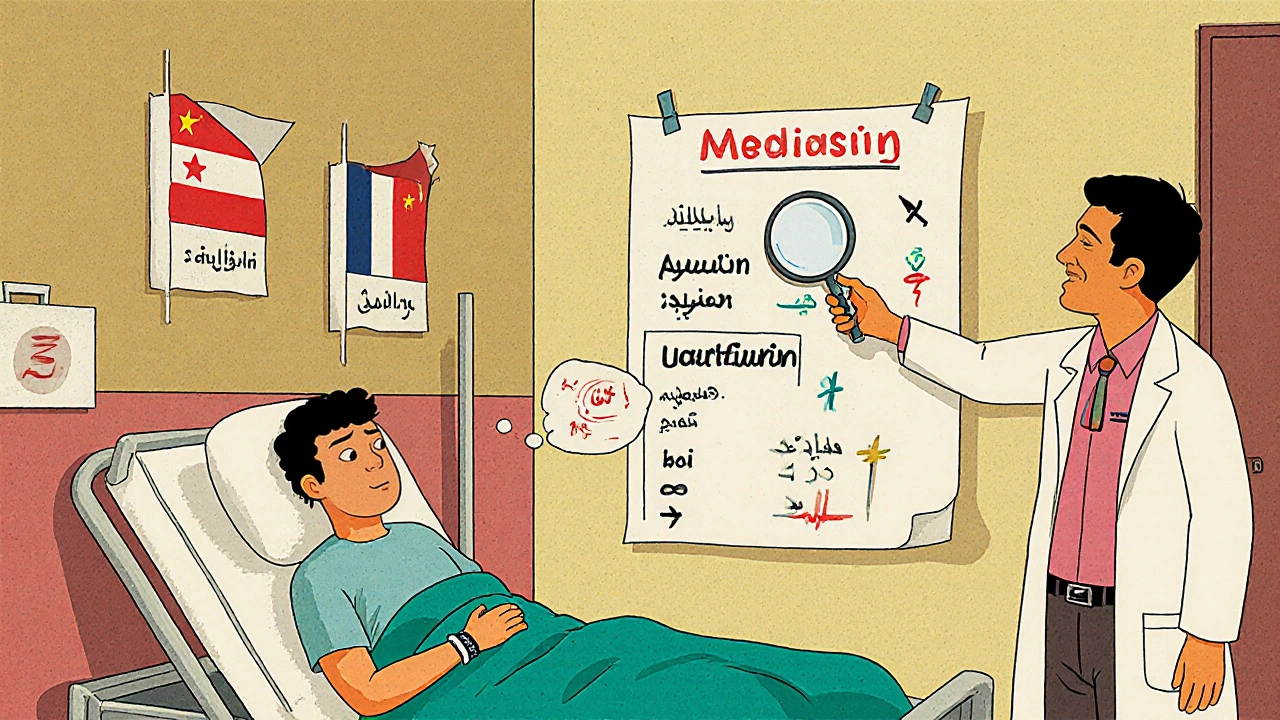
Digital vs. Paper: Which Works Better
Digital tools are convenient, but paper is reliable. In an emergency, paramedics won’t ask for your phone password. They’ll check your wallet or purse. So carry a printed copy - laminated if possible - in your wallet, purse, or even taped inside your passport.But don’t skip the digital backup. The NPS MedicineWise app lets you store your list, set dose reminders, and share it with family. It works offline, so no internet is needed. You can also email yourself a PDF version and save it in your cloud storage. If you’re using an iPhone, add your medication list to the Health app under “Medical ID.” It’s accessible from the lock screen - even if you’re unconscious.
Here’s the rule: One paper copy you carry. One digital copy you can access anywhere. That’s the sweet spot.
How to Make Sure It’s Accurate
A wrong translation is worse than no translation. A 2023 study found that 43% of translated medication instructions contained culturally inappropriate phrases - like using “sugar pills” for placebos in cultures where sugar is seen as medicine. Here’s how to avoid that:- Ask your pharmacist to review the translation. Most will do it for free.
- If you’re using a language like Chinese, ask for the version that matches your dialect. Simplified Chinese is used in mainland China; Traditional is used in Taiwan and Hong Kong. Using the wrong one can confuse older patients.
- Test it with someone who speaks the language. Have them read it and explain what it says. If they’re unsure, it needs fixing.
- Update it after every doctor’s visit. Medications change. So should your list.
One woman from Colombia told her doctor she was taking “aceite de oliva” for her heart. He assumed it was olive oil - a supplement. But she meant “acebutolol,” a beta-blocker. The names sounded similar. That’s why writing both brand and generic names matters.
What to Do When You’re Traveling
Before you leave:- Print your multilingual list. Put one copy in your wallet, one in your carry-on, and one with a travel companion.
- Save digital copies on your phone and in the cloud.
- Add your list to your phone’s emergency contact info (iPhone Health app or Android Emergency Information).
- Give a copy to a family member back home.
- Carry the British Red Cross phrasebook or print a few key phrases: “I take [medication],” “I am allergic to [drug],” “I need help.”
When you arrive:
- Keep your list with your ID and insurance card - not buried in your suitcase.
- If you’re staying in a hotel, leave a copy at the front desk. Ask them to note it in case you’re found unresponsive.
- Don’t assume the local pharmacy speaks English. Know where the nearest international clinic is.
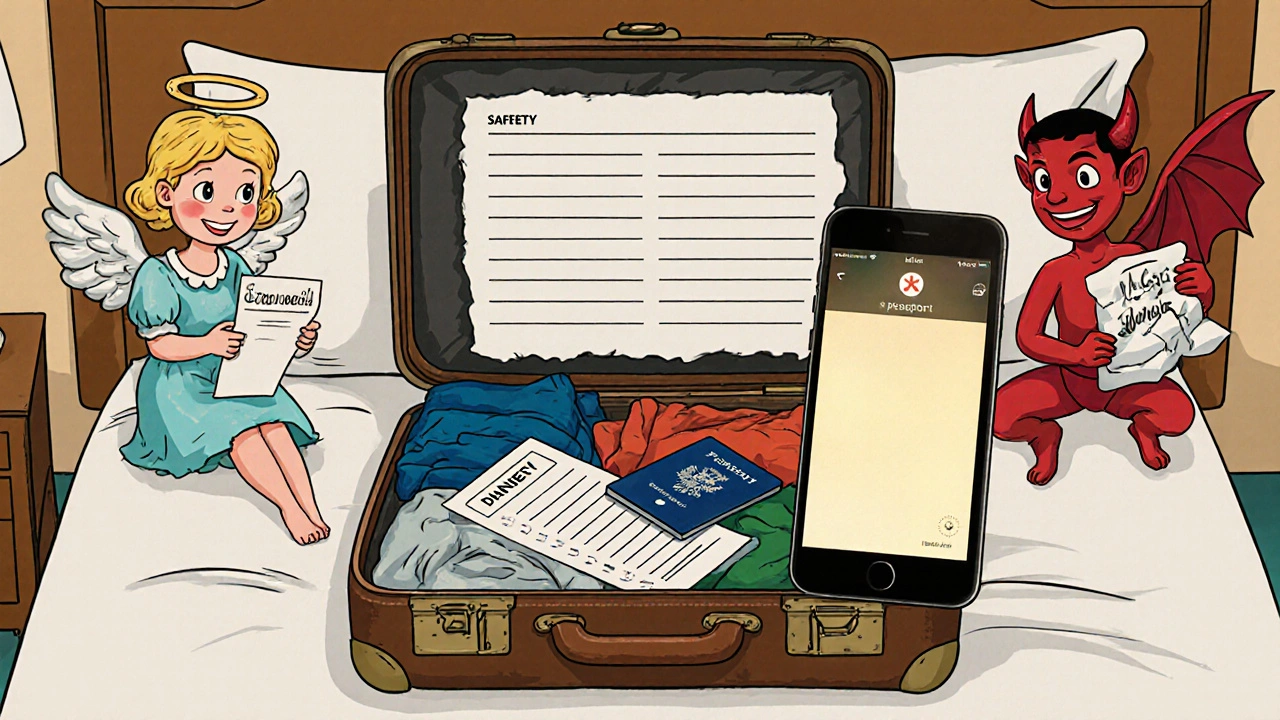
Common Mistakes People Make
Most people think they’re doing enough by writing down their meds. But here’s what goes wrong:- Using abbreviations - “B.P.” instead of “blood pressure,” or “1x” instead of “once daily.”
- Forgetting herbal meds - Turmeric, ginseng, garlic supplements - all can interact with prescription drugs.
- Not updating it - If you stopped a drug last month, cross it out. Outdated lists cause confusion.
- Only having it in English - Even if you speak English, your doctor abroad might not.
- Not testing the translation - A machine translation might say “take with food” when it should say “take before meals.”
One man from Lebanon forgot his list during a trip to Germany. He had a seizure and couldn’t speak. The hospital found his pills in his pocket - but no labels. He spent three hours in the ER while they tried to guess his meds. He now carries a laminated list in Arabic, English, and German.
Who Should Have One
You don’t need to be a senior or have a chronic illness to need this. Anyone who takes more than one medication regularly should have one. That includes:- People on blood thinners, insulin, or seizure meds
- Travelers with asthma, diabetes, or heart conditions
- Anyone taking herbal or alternative medicines
- Parents of children with special needs
- People with limited English proficiency
It’s not just for foreigners. An Australian tourist in Italy had a heart attack. He had a list in English - but the ER staff didn’t understand it. He survived, but only because his daughter was with him and translated. He now carries a list in Italian, too.
What’s Next
The world is getting more connected, and so are our medicines. In 2024, the CDC added new languages to its resources - including Amharic, Karen, and Tibetan - to serve refugee communities. Google now shows translated medication info directly in search results for over 100 drugs. But tools won’t help if you don’t use them.Your list is your safety net. Don’t wait for an emergency to make one. Spend 20 minutes today. Print it. Save it. Carry it. It could save your life - or someone else’s.
Can I just use Google Translate for my medication list?
No. Google Translate often misinterprets medical terms. For example, it might translate “as needed” as “when you feel like it,” which is dangerous. Always use official sources like NPS MedicineWise, Tennessee UML, or MedlinePlus. If you’re unsure, ask your pharmacist to review it.
Do I need a translation for every language I speak?
No. Focus on the languages of the countries you visit most. If you travel often to Spain, get Spanish. If you visit Vietnam, get Vietnamese. For general travel, English and your native language are enough. Add one more if you’re going somewhere with a high risk of language barriers.
What if I take a new medication while traveling?
Update your list immediately. Write down the new drug, dosage, and reason. Take a photo of the pill bottle and save it on your phone. When you return home, confirm with your doctor that it’s safe to continue. Never assume a local pharmacy’s advice is correct without checking with your regular provider.
Can I use my phone’s Health app for this?
Yes - but only as a backup. Your Health app (iPhone) or Emergency Information (Android) lets you store your meds and medical conditions. It’s accessible from the lock screen, which is great. But if your phone dies or is lost, you’re left with nothing. Always carry a printed copy too.
Are there apps that automatically translate my meds?
Not yet. Some apps, like MedicineWise, let you store your list in multiple languages, but you have to input the translations yourself. AI translation tools are being tested, but they’re not reliable enough for medical use. Human review is still required.
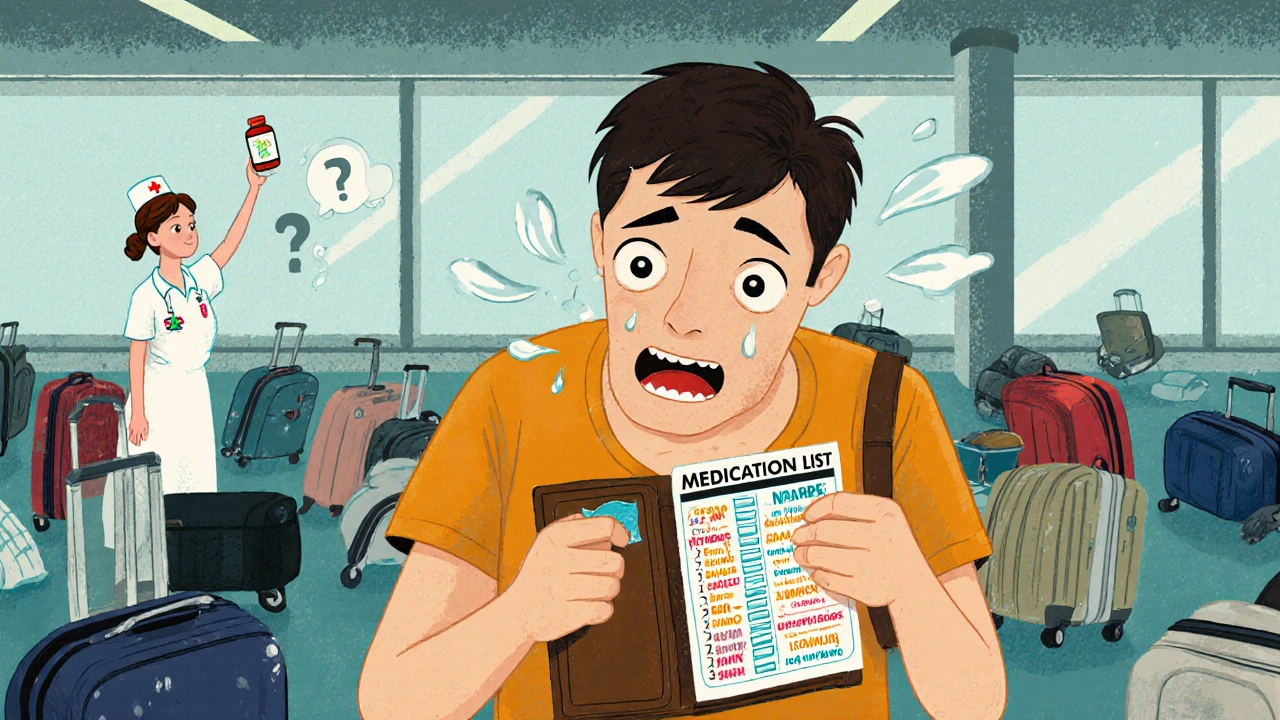
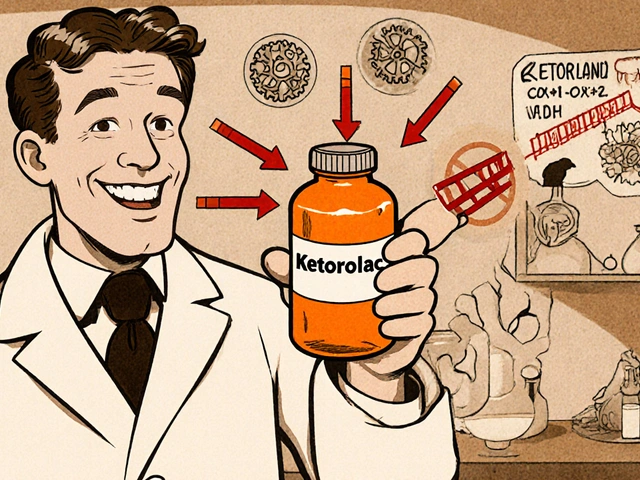


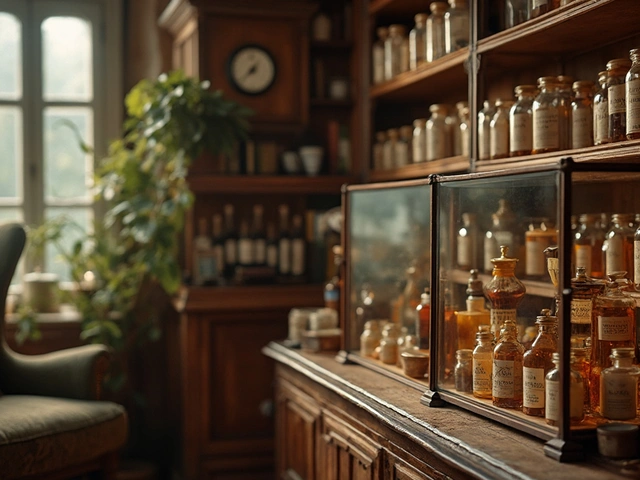
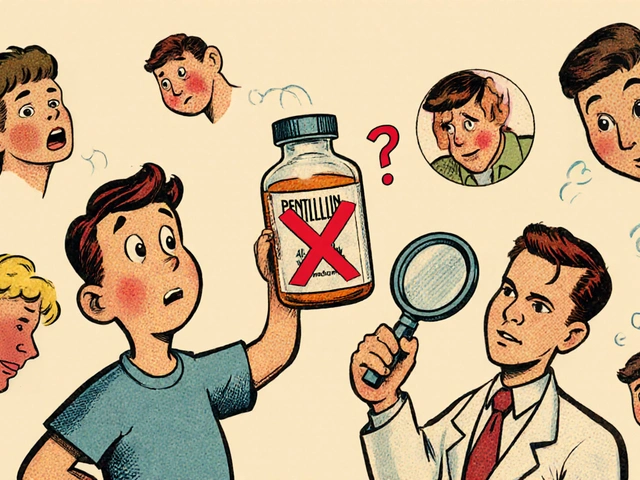
Comments
I never thought about how dangerous it is to just assume people understand your meds. I’m from India, and my mom takes six different things - some Ayurvedic, some Western. Last year she got hospitalized in Dubai and they had no idea what she was on. I printed her list in Hindi, English, and Arabic. Laminated it. Now it’s stuck to her purse like a badge of honor. Life-changing. Thanks for this.
Let me be crystal clear - using Google Translate for medication lists is not just irresponsible, it’s criminally negligent. I’ve seen ER nurses squint at ‘take 2x daily’ translated as ‘drink two times when you feel like it.’ That’s not a typo. That’s a death sentence. And no, ‘as needed’ does NOT mean ‘whenever you’re bored.’ The fact that people still do this makes me want to scream into a pillow. Use the NPS list. Or don’t. But don’t pretend you’re being safe when you’re playing Russian roulette with your liver.
You know what I love about this post? It doesn’t just tell you what to do - it shows you why it matters. I used to think I was fine with just having my meds in English because I speak it. Then I went to Japan and my phone died, my wallet got stolen, and I ended up in a tiny clinic in Kyoto where the nurse spoke zero English. She didn’t ask me anything - she just pulled out a laminated sheet from her drawer and handed it to me. It was the Tennessee UML. In Japanese. I cried. Not because I was sick - because someone had already thought of this for people like me. So yeah. Do it. Print it. Carry it. It’s not just a list. It’s a lifeline.
i just started taking blood pressure meds and i was like hmm maybe i should write this down but then i forgot until i read this now im printing mine right now and putting it in my wallet next to my id also i added my allergies because why not
It’s fascinating how we treat medication as if it’s a personal ritual rather than a biological variable. The assumption that translation is a linguistic exercise ignores the epistemological gap between pharmacological intent and cultural interpretation. When you say ‘as needed,’ you’re not just translating words - you’re translating a medical ontology. And most translations flatten that into colloquialism. The real problem isn’t the lack of PDFs - it’s the systemic devaluation of patient agency in cross-cultural care. We need standardized ontologies, not just bilingual forms.
Love this. Seriously. I used to roll my eyes at people who carried printed meds lists - until my cousin got into a bike accident in Mexico and the hospital couldn’t figure out if he was on anticoagulants. He had his list in English and Spanish. Saved his life. I made one for my whole family. Now we all have them in our wallets, phones, and even on our fridge magnets. It’s not dramatic. It’s just smart. And hey - if you’re reading this and you’re like ‘I’m healthy,’ ask yourself - when was the last time you got a new prescription? Yeah. Exactly.
This is so important 💕 I’ve been telling everyone I know to do this - especially my elderly neighbors. My grandma took her list to the ER last month after a fall and the nurses said it was the clearest one they’d seen all week. I printed hers in English and Tagalog (she’s Filipino) and even added little icons next to each pill - a heart for blood pressure, a sun for vitamins, etc. It’s silly but it works. And yes - laminated. Always laminated. 😊
I’m a nurse and I see this all the time. People come in with a phone full of screenshots of pills, scribbled notes on napkins, or worse - nothing. One guy had 17 medications and couldn’t name three. His wife had the list printed in Spanish but didn’t know it was in her purse. We found it after 45 minutes of panic. Don’t be that person. Make the list. Put it where you can find it. And if you’re traveling - carry two copies. One in your coat, one in your bag. Trust me. It’s the easiest thing you’ll ever do that could save your life.
Print. Laminated. Wallet. Done.
just made mine and added emojis for each med 🩺💊🫀🌿 and saved it in my phone and printed it. also put one in my suitcase and one with my mom. i even showed my dog and he looked confused but i think he’s proud 🐶❤️ this is the most chill thing i’ve done for my health. thanks for the nudge!
You think this is about medication? Nah. It’s about control. The modern American obsession with documenting everything - your pills, your mood, your diet, your sleep - it’s not safety. It’s fear dressed up as responsibility. You don’t need a list. You need to stop taking so many damn pills in the first place. But hey, if laminating a piece of paper makes you feel like you’ve ‘done your part,’ go ahead. The ER won’t care. They’ll just look at your vitals. But sure. Keep your little color-coded charts. It’s adorable.
Used the NPS list when I went to Bali last year. Got food poisoning and ended up in a clinic where the doctor only spoke Bahasa. He read my list, nodded, and gave me the right meds. No confusion. No guesswork. I didn’t even have to speak. That’s power. I now have versions in English, Bahasa, and Thai. I even got one in Mandarin for my next trip to Shanghai. It’s not extra work - it’s just planning. Like packing sunscreen. Only this one doesn’t burn.
My dad had a stroke in Greece and they couldn’t figure out his meds. He had a list… in English. We were there with him and translated everything on the spot. He’s fine now but it was terrifying. I made a list for all of us last weekend. Printed three copies. One in the car, one in my wallet, one in the house. And yeah - I put it in my phone too. Simple. But if you’ve ever been scared for someone you love - you’ll get it.
man i just realized i never updated mine since last year when i stopped the statin. i was like oh i dont take that anymore and forgot to cross it out. now im going to sit down and fix it. also i added my omega-3s because why not. and i printed it in like 3 languages because i travel a lot and i dont want to be that guy who gets stuck in a hospital with no clue what he's on. thanks for the reminder
My sister is a pharmacist and she says the biggest mistake people make is forgetting supplements. She had a patient who took ashwagandha for anxiety and it interfered with his thyroid med. No one told the doctors. He ended up in the ICU. So now I list everything - even the turmeric capsules I take for my knees. It’s not just prescriptions. It’s all of it. And I always double-check the spelling. Because one letter can change everything.